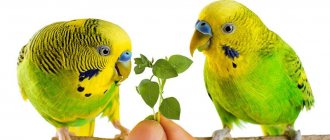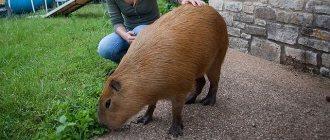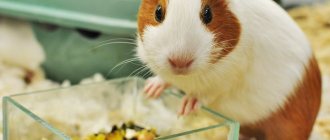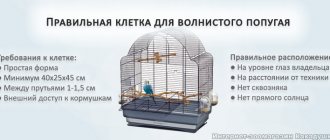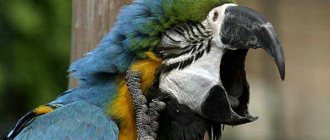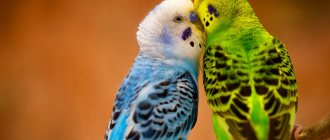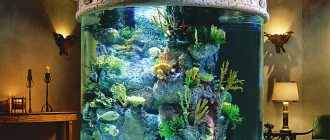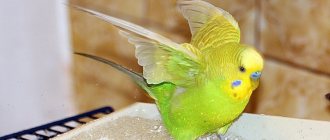- home
- Parrot
- Arrangement
05/18/2019 If you have chosen a parrot as your favorite pet, you need to organize a convenient place for it in your apartment or house. Of course, he will spend most of the day in his crate, so it should have everything you need for your pet's comfort. A perch is one of the most important pieces of “furniture” for a parrot of any species. Nowadays pet stores offer a wide selection of their varieties, but first you need to figure out which one is suitable for your bird.
Types of perches
Perches (perches, perches) are varied.
| Perches for parrots | ||
| Artificial | pros | Flaws |
| Plastic | They are easy to wash and clean, so they are recommended when the parrot is sick, when complete disinfection is required. | • Cannot be used daily. • Parasites grow in cavities. • Provoke the formation of calluses. |
| Rubber | • Change shape if necessary. • Suitable for walking areas. | The dye and other chemical components in the composition may pose a threat to the health of the feathered pet. |
| Braided from cotton threads on top and with wire inside | • Decorate the interior. • Made from natural cotton material. | There is a risk that the parrot may clog the crop with threads or become entangled in them. |
| Perch nozzles with sand spraying | • Option for grinding claws. | • Paw skin irritations • Calluses |
| Concrete or cement perches | • Grinding of claws and beak. • Additional additive. | • Cold (there is a risk of freezing feet). • The goiter may become clogged. |
| Additives made of pumice (volcanic stone) | • Only for grinding beak and claws | • Not suitable for sitting. |
| Made or sprinkled with small mineral stones | • Grinding claws and beak. • Additional mineral feeding. • Additional additive. | • Mineral perches are not used for prolonged sitting. |
| Heated perches | • Used for outdoor enclosures and outdoor walking areas. | If a bird pecks at the wire used for heating, it may die from an electric shock. |
| Natural | pros | Flaws |
| From tree branches (selected independently) | An ideal option that provides maximum comfort and recreates the natural environment. | No |
| Wooden perches - factory-made (store-bought version) | If the diameter is selected correctly, they are well suited for birds. | • Requires improvement - it is necessary to scrape out nicks and grooves on the perfectly smooth surface of the branches, otherwise the bird will feel pressure on the limbs. • They do not have bark, which helps to wear down the beak. |
We prepare the material
There are certain rules for preparing twigs for parrot perches.
Where and how?
- We go to the forest for suitable materials. It is necessary to do this away from roads, landfills, and industrial enterprises.
- You shouldn’t take risks with “dacha” branches either: what if the trees were sprayed for pests?
- carefully for any parasites or rot on the branches.
- Fresh branches should also not be used immediately as perches: the raw materials are first thoroughly washed with a brush with warm water, then doused with boiling water and dried.
There is no need to remove the bark from the branches: the parrot, gnawing on them, will grind off its beak, at the same time “refueling” with a certain vitamin and mineral dose.
It is recommended to make perches from different wood species, since all trees and shrubs have different hardness and porosity. Over time, you can determine which tree perch your pet likes to chew on the most, and pamper him with his favorite type of wood.
It is recommended to place the shoots cut in autumn in a vessel with clean water and wait until the buds swell, and then use the twig as a perch. Such a perch will serve the parrot as an additional and healthy treat, as it will contain many vitamins, fiber and microelements.
Length and thickness
Pets will love perches of different diameters.
The perches should be equal to the length and width of the cage plus 5–7 mm - they should protrude slightly beyond the boundaries of the parrot’s home. As for the diameter, the most convenient perch thickness for wavy birds is no less than 1.5 cm. If the perch is thinner, it will create excessive stress on the bird’s legs. The parrot's fingers should rest on the perch, not hang under it, and its claws should touch the perch.
To prevent the legs from getting too tired while in one position, it is recommended to place perches of different thicknesses in the bird’s home. If there are perches of different thicknesses in the cage, the parrot will choose the one that suits him best at the moment.
It’s good if the diameter along the entire length of one additive is not the same. In this way, “corns” on the bird’s feet can be avoided, since the pressure on the same places will be reduced.
Installing the perch step by step
We've sorted out the material for making the additive.
- Tools needed: knife, fine-toothed hacksaw, tape measure, garden pruner.
- The cage is measured in accordance with the intended location of the perch - along the length or width of the home.
- The branch is cut slightly longer than the established size.
- A small cut is made at the end of the branch.
- The same cut is made on the other side.
If the attachment will be attached at the junction of the rods, then the cuts are made cross-shaped.
- The poles are installed in their designated place.
Why do parrots need perches in a cage?
The poles perform a number of functions necessary for the normal functioning of parrots:
- Act as an overnight stay.
- They are part of the daytime pastime.
- They help to grind down the claws and beak.
- They help birds develop their paw muscles.
For each type of parrot, the types of poles are selected individually.
It all depends on the following aspects:
- number of birds in the cage;
- the size of the bird (the diameter of the perch should be such that the parrot can clasp it well with its toes, and the bird does not experience any discomfort).
Selection criteria
When choosing a perch for a budgerigar, you should definitely clarify the method of attaching it. On sale you can find ordinary blocks that you have to polish yourself. While more expensive solutions offer several mounting options. more critical characteristics are the size of the perch and the material.
Is it worth getting a parrot?
Not really
Diameter
For adult budgies, the diameter of the crossbar should be around 15-18 mm. If young animals are planned to appear in the cage, then it is necessary to take care of 8-10 mm perches. It’s good if the crossbars in the cage are of different diameters, then the bird itself will choose the best option for it.
Material
Flat designs should be avoided. Parrots need to sharpen their beaks and claws, so it's best to look towards abrasive materials. But the main thing here is not to overdo it, otherwise the sharp crumbs can injure the skin on your paws. In addition to perches for sharpening beaks and claws, regular perches should be installed. In this case, heat-saving materials such as wood are suitable.
You should never use toxic products - only environmentally friendly ones. It is dangerous to install household plastic or other similar synthetic material into a cage.
In the hot summer months, when the product begins to emit fumes under the influence of high temperatures, the pet may be poisoned.
Correct placement of perches in the cage
Perches are placed based on the following rules:
- For 1 bird you will need 2-3 pieces.
- The bird's paw should wrap 75% around the pole.
- Perches should not interfere with free movement.
- They are not mounted exactly on top of each other, so as not to get dirty with droppings.
- They are located at different levels (one for sleeping higher - the parrot should not touch the ceiling with its head, and others lower - so as not to touch the bottom with its tail).
- For frequent walking, some of the poles are attached from the outside of the cage - on the roof or on the side wall.
- When several feathered pets live, their perches are placed taking into account that the birds do not touch each other.
Try changing the position of the poles sometimes. In most cases, parrots like such changes and sometimes even cause delight. As an option, hang the poles separately in the room, make a stand out of them, a swing in a cage, or a kind of toy.
Parrot does not eat fruit - causes of the problem
Many owners face this problem. Most often, the reason that a parrot does not eat fruit is incorrect maintenance, which leads to fear of everything new. Here are a couple of examples:
We recommend reading: Drontal Anti-Worm For Kittens
In particular, for the above reasons, the Kakadushka pet store does not sell birds, so as not to become like similar stores, but recommends contacting nurseries and breeders, where they are provided with proper care and maintenance.
Which poles should not be used?
For constant pastime, it is strictly forbidden to use the following types of poles:
- Made of plastic;
- From pumice;
- Flexible rubber;
- Threaded cotton;
- Made of concrete.
The use of the above perches is permissible only as a temporary accessory during disinfection or as an additional seating area in places where birds rarely visit.
The wooden options that are offered in the store are used only after additional processing (notching), since they have a smooth, even surface that is not suitable for birds.
Multi-colored budgies
It is also unacceptable to use additives made from prohibited tree branches or store-bought versions of questionable production with damaged packaging.
Branches lying on roadsides or in landfills should not be used. It is also prohibited to cut branches from trees that have been sprayed with chemicals. In both cases, neglecting this recommendation poses a threat to the health of the bird.
Vegetables for poultry
Vegetables are rich in substances beneficial to the bird's body: microelements and vitamins. Any vegetables should be fresh and, if possible, seasonal. They must first be washed under running water to get rid of various toxic chemicals that are often used to spray vegetables. Parrots can be given the following vegetables:
But giving birds garlic, celery, radishes, onions, radishes, eggplant, and potatoes is strictly prohibited. They contain a high content of harmful substances - essential oils or solanine.
Before serving vegetables to your pet, they must be either finely chopped or grated. You can feed your parrot some vegetables separately or add them to other foods. Birds accustomed to vegetable crops happily eat porridge with pieces of vegetables.
How to make perches for parrots with your own hands
DIY wooden poles are the best option for parrots. Making them is quite simple if you read the step-by-step instructions and take into account the advice of experienced poultry farmers on selecting and using the right material.
| Tree branches | |
| Authorized for use | Strictly prohibited |
| • Cherry • Apple • Plum • Citrus • Raspberry • Viburnum • Currant • Linden • Hawthorn • Hornbeam • Beech • Aspen • Ash • Rowan • Sea buckthorn (without thorns) • Birch • Maple • Willow • Alder • Walnut (without leaves) | • Oak (contain tannins) • Pear (contain tannins) • Bird cherry (lots of tannins) • Poplar (absorbs toxins from the air) • Conifers (lots of toxic resins) • Lilac (lots of toxic compounds) • Elder (causes severe distress) Gastrointestinal tract) • Acacia (contains bird poisons) • From the coffee tree (high caffeine content) |
It is recommended to cut or saw off branches, but not to break them. After cutting, the scar on the tree should be treated with garden varnish.
The optimal time of year to collect twigs is late spring, summer or early autumn.
Greens for poultry
Is it possible to give birds spicy and fragrant herbs, for example, parsley, dill or cilantro? No, they are harmful to wavy pets. But you shouldn’t completely give up greens. Many parrots will happily gnaw clover, dandelion, fireweed, grapevine, carrot or beet tops, and plantain.
Some gourmet birds love young leaves of birch or willow. However, you should not get carried away - remember that by the end of summer, various harmful substances begin to accumulate in the leaves of trees, so pamper your pet only with spring and summer leaves.
It is best to give the bird the greens that grow in the garden or, at least, away from the roadway.
What does your parrot like?
Please share this article with your friends and like it.
A budgie can become poisoned due to an overdose of harmful substances contained in fruits such as mango, persimmon, papaya, and avocado. Therefore, they should never be given to your pet.
Fruit for poultry
For budgies, fruit is often not food unless they have been taught to eat it since childhood. Therefore, the pet may refuse such food. However, getting him accustomed to eating this complementary food is one of your main tasks. Try to unleash your creativity and present the bird with an original cut watermelon, apples or a fruit “garland”. The main thing is to be patient and persevere.
Now let's look at what fruits parrots can eat. “Wavins” can be given the following:
You can also give your pet peach, apricot, kiwi, pineapple, and pomegranate as a treat. These fruits have a high content of various vitamins, microelements and fructose. Any fruit must be served to the bird only fresh, pre-washed. Some foods need to be peeled before serving. For example, banana or orange.
A budgie can become poisoned due to an overdose of harmful substances contained in fruits such as mango, persimmon, papaya, and avocado. Therefore, they should never be given to your pet.
Trees and shrubs useful for birds
In the recipes of traditional healers, in addition to flowers and fruits, you can often find stems, branches and bark. Some substances necessary for the body are contained in them in greater quantities than in berries and fruits from the same tree. For a pet, a parrot perch made from a branch of a tree or shrub that is useful for it can become a source of vitamins and a place of natural habitual rest.
You need to know which branches are suitable for a budgie
Under natural conditions, parrots often eat bark from trees on which they rest, roots and leaves, even if there is a sufficient amount of seeds and fruits.
For a parrot, branches need to be cut from certain types of trees and shrubs and carefully prepared.
Budgerigars love to walk along the bottom of the enclosure. They will be happy to find a few twigs there to chew on. Also, to charge the birds, which are habitually mobile by nature, they need to attach branches to the walls of the cage from the inside. The bird should reach them, stretching out to its full height, but without straining too much.
Small twigs can be placed on the bottom of the enclosure, as parrots love to walk
Branches for parrots are as necessary as sepia and fresh fruit. They contain fiber and vitamins that birds cannot get from seeds and fresh produce. The Budgerigar's beak has a notch at the end. They need constant work, chewing on something hard. It is this unsatisfied need that makes your pet chew baseboards and tear wallpaper.
What branches can be given to budgies and where to get them. You can cut branches from fruit trees:
Some shrubs in your garden are also suitable for “gnawing”:
You can choose an apple, plum or apricot branch for your pet
What branches can be given to parrots, raw or do they need to be prepared? Freshly cut branches should not be given to parrots. First they need to be dried a little, then processed. Remove all thorns, remove moss, dirt, and fungal growths. The peeled branches should be placed in water for 10–12 hours. After this, soak in boiling water or heat in the oven for 5 - 10 minutes, depending on the thickness. The bulk of mites and fungi die at a temperature of 60 degrees. When treating bird toys and sticks, it is better to play it safe and raise the temperature. Wood is a good heat insulator. It takes time for the inside of a thick branch to warm up.
Do not wash chews and bird toys with any detergents. As a last resort, use baking soda, and rinse well afterwards with hot and cold running water.
In the bark itself and under it, many microbes, fungal pores, and mites collect. The wood itself may contain various wood-boring beetles, their eggs and larvae. All this can harm the parrot if it gets into its stomach.
Parrots at home catch diseases very easily. Treatment is complex and not always successful. It is better to take care of the cleanliness of toys and food, make the cage correctly and place it in a safe and convenient place for the bird.
